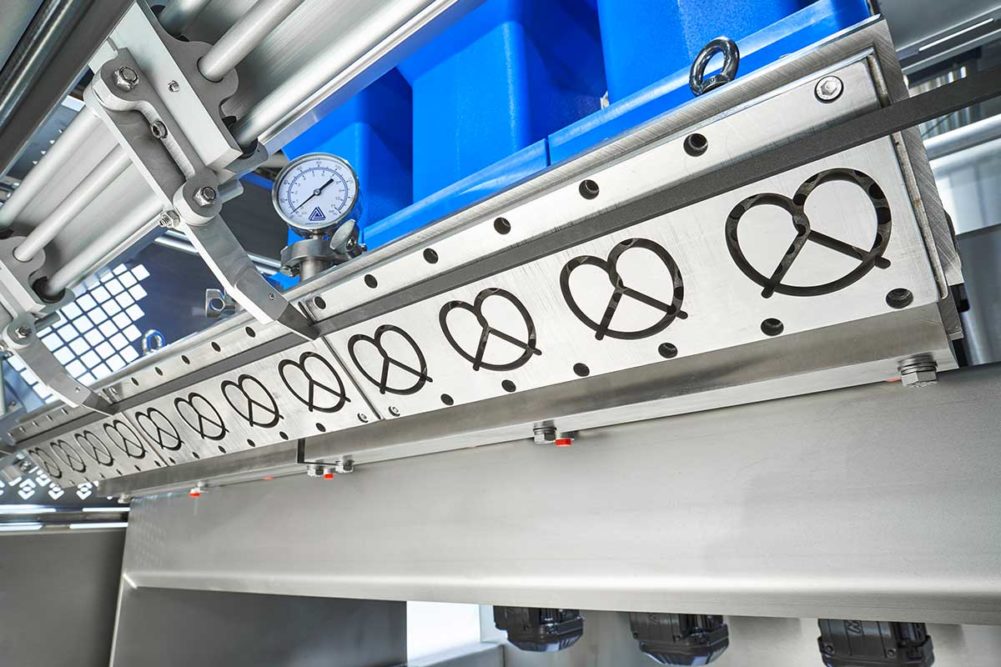When it comes to delicate or difficult-to handle doughs, extrusion provides bakers with multiple options.
Handtmann uses an adjustable vane cell feeding system that offers a much shorter product path, creating less product contact with metal and less friction to better maintain dough quality, said Ken Hagedorn, vice president of bakery sector for the company.
The system also retains the ingredient identity and visual appearance of delicate inclusions and can handle a wide range of products, including most gluten-free doughs.
Meanwhile, Rheon co-extruders rely on a specialized mechanism that is able to cut, wrap and seal an exterior casing around a filling. This mechanism or shutter also allows for the cutting of very viscous materials.
“We have found that most gluten-free doughs are quite sticky, and our shutters cut them very well,” said John Giacoio, vice president of sales, Rheon USA.
John McIsaac, vice president, strategic business development, Reiser, said food companies can combine two of its Vemags with a Reiser-engineered co-extrusion attachment to produce an assortment of filled products.
“With the co-extrusion system, the first Vemag supplies the product’s outer shell while the second system supplies the filling,” he said. “The forming attachment gives the product its shape, and a crimper ensures securely sealed product ends. Alternatively, a device can be used to cut the product to uniform lengths with open ends.”
Hagedorn pointed out that Handtmann’s Triple Co-ex system produces pastry snack items where dough rolls are filled with two inner linings.
“In this case, a core product is surrounded by an intermediate filling, and both are then enclosed in an outer layer of dough,” he explained. “The flexibility of this technology also allows for a variety of different savory or sweet creations with smooth and chunky fillings. Current uses include baked items with a meat or vegan core surrounded by a spicy sauce and then the dough layer, and extruded soft cheese or yogurt surrounded by a sweet fruit filling and the dough.”
Bruce Campbell, product group leader for Flex, an AMF Bakery Systems brand, said the company has created a simpler, lower-pressure path for the extrusion of bread, rolls, tortillas and pizza production doughs. That allows a wider range of grain structures to be produced from extrusion dividers.
“We made it easier to run these high-speed machines and create some differentiation in the end products,” he said.
For smaller, personal-sized pizzas, he added, AMF developed a pressed pan pizza system where extruded dough drops into the pan at about 80 cuts per minute, and then that whole pan gets pressed at once.
“It allows the bakery to have high efficiencies and still create that same structure,” Campbell said. “This advancement wasn’t necessarily for creating innovative new products for bakeries, but rather it was an innovative new way to make their products at a higher efficiency rate.”
Ty Sarajian, president, Axis Automation, said extruders are equipped with more efficient motors and sophisticated control systems.
“This combination allows for faster extrusion rates while maintaining precision, enabling producers to increase their output without compromising the quality of the products,” he observed.
For some snack producers, smaller is better, especially for co-manufacturers with a broad product portfolio, suggested Jenni Harrington, director of sales and technology, Bühler.
“With the need for flexibility, midsize extruders are best,” she said. “When you start up and shut down, you generate waste. Smaller systems are easier to shut down, remove the die, clean and start up again in 15 to 20 minutes with proper planning.”
With extrusion, there are hardly any borders when it comes to creating new products.
To reinvent the market, bakers and snack makers only need to leave it up to their imagination.
This article is an excerpt from the February 2024 issue of Baking & Snack. To read the entire feature on Extrusion, click here.





